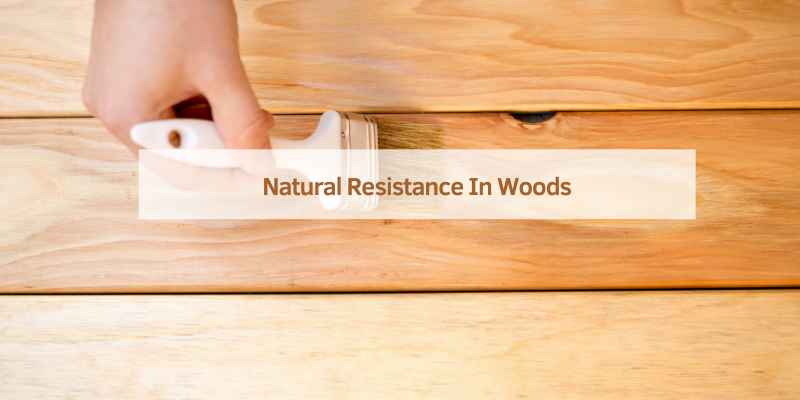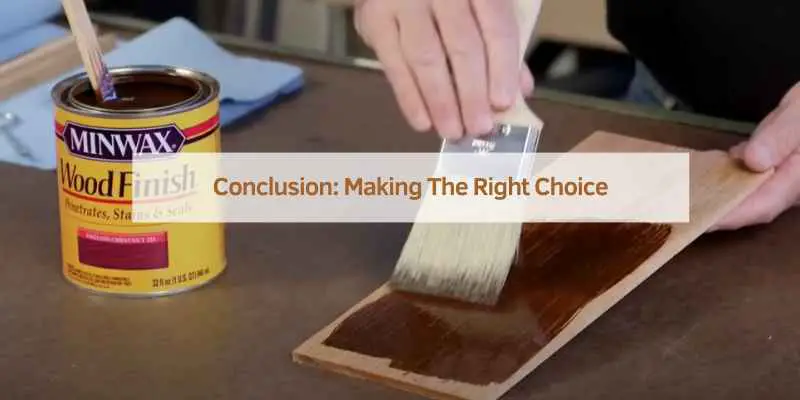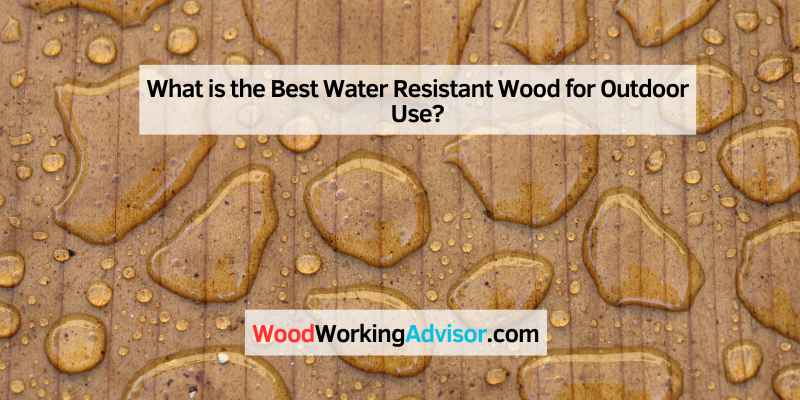Teak is the best water-resistant wood due to its natural oils and durability. It is commonly used in outdoor furniture and marine applications.
Teak’s ability to withstand water damage makes it a popular choice for various outdoor projects. Its resistance to rot and decay, along with its attractive appearance, make teak a top choice for those seeking long-lasting and weather-resistant wood options. Additionally, teak is easy to maintain and does not require constant sealing or treatment, making it a practical and aesthetically pleasing choice for outdoor use.
Introduction To Water Resistant Woods
When it comes to outdoor wood projects, using water-resistant wood is essential for ensuring durability and longevity. Water-resistant woods are specifically designed to withstand moisture, making them an ideal choice for outdoor furniture, decks, and other exterior applications. In this article, we will explore the best water-resistant woods and their key properties, as well as the benefits of using them for outdoor projects.
Benefits For Outdoor Use
Water-resistant woods offer a range of benefits for outdoor use, making them highly suitable for various applications. Some of the key benefits include:
- Resistance to rot and decay
- Enhanced durability in humid and wet conditions
- Reduced maintenance requirements
- Extended lifespan of outdoor structures
Key Properties
Water-resistant woods possess specific properties that make them well-suited for withstanding moisture and outdoor elements. These key properties include:
- High natural oil content
- Tight grain structure
- Natural resistance to fungal growth
- Low moisture absorption rate
Natural Resistance In Woods
When it comes to finding the best water-resistant wood for outdoor projects, it’s essential to consider the natural resistance that certain wood species possess. Understanding the natural properties of different woods can help you make an informed decision when selecting the most suitable material for your specific needs.
Tropical Hardwoods
Tropical hardwoods, such as teak, ipe, and mahogany, are renowned for their exceptional resistance to water and decay. These woods contain natural oils and dense fibers that make them highly resistant to moisture, making them ideal choices for outdoor applications such as decking, furniture, and boat building.
Domestic Varieties
Domestic wood varieties like cedar, redwood, and cypress also exhibit natural resistance to water and decay. These woods contain natural preservatives that make them durable and well-suited for outdoor use. Cedar, in particular, is known for its distinct aroma and ability to withstand moisture, making it a popular choice for outdoor furniture and siding.

Top Choices For Durability
For the best water-resistant wood, consider teak and cedar due to their exceptional durability and natural resistance to water damage. These top choices ensure long-lasting quality for outdoor furniture and structures.
When it comes to outdoor furniture, it is important to choose the right type of wood that can withstand the elements. Water-resistant wood is a great option for outdoor furniture as it can prevent rot and decay. However, not all water-resistant woods are created equal. In this article, we will discuss the top choices for durability and highlight their unique characteristics.
Teak: The Time-tested Favorite
Teak is a popular choice for outdoor furniture due to its durability and resistance to water damage. It is a dense, oily wood that is naturally resistant to rot, insects, and moisture. Teak can withstand extreme weather conditions and can last for decades without any maintenance. This wood is also known for its beautiful golden-brown color that can turn into a silvery-gray patina over time.
Cedar: Lightweight And Stable
Cedar is a lightweight and stable wood that is resistant to rot, decay, and insects. It has a natural oil that makes it resistant to water and moisture, which makes it a great choice for outdoor furniture. Cedar is also known for its beautiful reddish-brown color that can turn into a silver-gray patina over time. This wood is easy to work with and can be stained or painted to match any outdoor decor.
Redwood: Naturally Resistant To Decay
Redwood is a popular choice for outdoor furniture due to its natural resistance to decay and insects. It is a dense wood that can withstand harsh weather conditions and can last for decades without any maintenance. Redwood has a beautiful reddish-brown color that can turn into a silver-gray patina over time. This wood is also easy to work with and can be stained or painted to match any outdoor decor.
Cypress: Durable And Strong
Cypress is a durable and strong wood that is naturally resistant to rot and decay. It is a dense wood that can withstand extreme weather conditions and can last for years without any maintenance. Cypress has a beautiful golden color that can turn into a silver-gray patina over time. This wood is also easy to work with and can be stained or painted to match any outdoor decor.
In conclusion, choosing the right water-resistant wood for your outdoor furniture can ensure longevity and durability. Teak, cedar, redwood, and cypress are all great choices for their natural resistance to water damage and their unique characteristics. When deciding which wood to choose, consider the climate and weather conditions in your area, as well as the overall look and style you want to achieve.
Evaluating Hardwood Options
When it comes to choosing the best water-resistant wood for your outdoor projects, it’s crucial to evaluate different hardwood options. Two popular choices known for their durability and resistance to water damage are Ipe and Mahogany.
Ipe: The Dense Forest Gem
Ipe wood, also referred to as Brazilian Walnut, is a dense and durable hardwood that is naturally resistant to rot and decay. Its rich brown color and fine grain make it an attractive choice for outdoor applications.
Mahogany: Classic Aesthetic Appeal
Mahogany wood is prized for its classic aesthetic appeal and natural resistance to water. Its reddish-brown hue and straight grain pattern add elegance to any outdoor space, making it a timeless option for decking and furniture.
Softwood Possibilities
Softwood possibilities offer a range of water-resistant options for various woodworking projects.
Redwood: Vibrant And Resilient
Redwood is known for its vibrant color and resilience against water damage.
Cypress: Insect And Rot Resistant
Cypress wood is naturally resistant to insects and rot, making it ideal for outdoor use.
Alternative Treated Woods
Alternative treated woods such as cedar, redwood, and cypress are the best water-resistant options. These woods contain natural oils and resins that act as barriers against water and insects, making them ideal for outdoor use.
Alternative Treated Woods: Pressure-Treated Lumber and Thermally Modified Wood
When it comes to finding the best water-resistant wood, there are a variety of options available. While some may opt for natural rot-resistant wood species like cedar or redwood, others may choose to use alternative treated woods for added durability. Two popular choices for treated wood are pressure-treated lumber and thermally modified wood.
Pressure-Treated Lumber
Pressure-treated lumber is a popular choice for outdoor projects due to its ability to resist decay and termite damage. This type of wood is treated with chemical preservatives that help protect it from moisture, insects, and fungal decay. The preservatives are forced into the wood under pressure, which helps ensure that the treatment penetrates deep into the wood.
One of the benefits of pressure-treated lumber is its affordability. It is widely available and tends to be less expensive than other types of treated wood. Additionally, it is relatively easy to work with and can be cut and shaped to fit a variety of projects.
However, it’s important to note that pressure-treated lumber does have some drawbacks. The chemicals used in the treatment process can be harmful to humans and pets if ingested, and the wood should not be burned due to the release of toxic fumes. Additionally, some people may have concerns about the environmental impact of using chemically treated wood.
Thermally Modified Wood
Thermally modified wood is another alternative treated wood that is becoming increasingly popular in the construction industry. This type of wood is heated in a kiln at high temperatures, which changes the wood’s cellular structure and makes it more resistant to moisture, insects, and decay.
One of the benefits of thermally modified wood is its natural appearance. The high heat treatment process gives the wood a darker, richer color, and it can be left untreated without sacrificing durability. Additionally, because it is a natural material, it is environmentally friendly and does not contain any harmful chemicals.
However, thermally modified wood is typically more expensive than pressure-treated lumber, and it may not be as widely available. Additionally, it can be more difficult to work with due to its increased density.
In conclusion, when it comes to choosing the best water-resistant wood for your project, there are a variety of options available. Pressure-treated lumber and thermally modified wood are both popular choices for their durability and resistance to moisture and decay. Ultimately, the choice between the two will depend on your budget, personal preferences, and the specific needs of your project.
Sustainability And Eco-friendly Picks
When it comes to choosing water-resistant wood, it’s not just about durability and aesthetics. It’s also important to consider sustainability and eco-friendliness. By opting for wood that is both water-resistant and environmentally responsible, you can have the best of both worlds.
Reclaimed Wood Options
One sustainable choice for water-resistant wood is reclaimed wood. This refers to wood that has been salvaged and repurposed from old buildings, barns, or other structures. By using reclaimed wood, you are not only preventing it from ending up in a landfill but also reducing the demand for new wood.
Reclaimed wood has a unique charm and character that cannot be replicated by new wood. It often features natural weathering and patina, adding a rustic and authentic touch to any project. Additionally, since reclaimed wood has already gone through the natural aging process, it tends to be more stable and resistant to water damage.
Certified Sustainable Woods
If you prefer new wood for your water-resistant projects, there are certified sustainable options available. These woods come from responsibly managed forests that prioritize environmental stewardship and maintain a healthy ecosystem.
Look for certifications such as the Forest Stewardship Council (FSC) or the Sustainable Forestry Initiative (SFI). These certifications ensure that the wood has been sourced from forests that are managed with sustainable practices, including replanting trees and protecting wildlife habitats.
By choosing certified sustainable woods, you can have peace of mind knowing that your water-resistant wood comes from ethical and environmentally conscious sources. These woods not only provide the desired water resistance but also contribute to the long-term health of our forests and planet.
Maintenance And Longevity
When it comes to choosing the best water-resistant wood for your outdoor projects, considering the maintenance and longevity is crucial. Proper sealing techniques and regular care practices can significantly extend the lifespan of your wood, ensuring it remains durable and attractive for years to come.
Proper Sealing Techniques
Properly sealing your water-resistant wood is the first line of defense against moisture damage. It creates a protective barrier that prevents water from penetrating the wood fibers and causing rot or decay. Here are some effective sealing techniques:
- Choose the right sealant: Opt for a high-quality waterproof sealant specifically designed for wood. Look for products that offer long-lasting protection against UV rays, mold, and mildew.
- Clean and prepare the wood: Before applying the sealant, ensure the wood surface is clean and free from dirt, debris, and old sealant. Sanding the wood lightly can help create a smooth surface for better adhesion.
- Apply multiple coats: To achieve optimal protection, apply multiple thin coats of sealant rather than a single thick coat. This allows for better absorption and penetration into the wood.
- Follow manufacturer’s instructions: Always follow the manufacturer’s instructions regarding application methods, drying times, and reapplication intervals. This ensures you get the best results and maximum longevity.
Regular Care Practices
In addition to proper sealing, regular care practices are essential for maintaining the water resistance and longevity of your wood. Here are some simple yet effective care practices to consider:
- Keep the wood clean: Regularly remove dirt, leaves, and other debris from the wood surface. This prevents the buildup of moisture-trapping materials and reduces the risk of decay.
- Inspect for damage: Periodically inspect your water-resistant wood for any signs of damage, such as cracks, splinters, or discoloration. Promptly address any issues to prevent further deterioration.
- Reapply sealant as needed: Over time, the protective sealant on your wood may wear off due to weather exposure. Keep an eye on the condition of the sealant and reapply as recommended by the manufacturer.
- Protect from extreme weather: Whenever possible, protect your wood from extreme weather conditions, such as heavy rain, direct sunlight, or snow. Using appropriate covers or providing shade can help prolong its lifespan.
By implementing proper sealing techniques and regular care practices, you can ensure the longevity of your water-resistant wood. These maintenance efforts not only protect your investment but also enhance the beauty and durability of your outdoor projects.
Innovative Composite Materials
Discover the best water-resistant wood with innovative composite materials. These advanced materials offer exceptional durability and moisture resistance, making them ideal for outdoor applications. Their unique composition provides long-lasting performance and a natural appearance, perfect for a wide range of projects.
Comparing To Natural Wood Pros And Cons
Innovative composite materials are becoming increasingly popular as a water-resistant alternative to natural wood. While natural wood has been used for centuries, it is prone to rot, decay, and insect damage, especially when exposed to moisture. On the other hand, composite materials are engineered to be water-resistant, durable, and low-maintenance. Let’s take a closer look at the pros and cons of using innovative composite materials compared to natural wood.
Pros Of Using Innovative Composite Materials
Composite materials have several advantages over natural wood. Here are some of the key benefits:
- Water-resistant: Composite materials are engineered to resist moisture, which makes them an ideal choice for areas that are prone to rain, humidity, or water exposure.
- Durable: Composite materials are made to withstand wear and tear, and they can last for years without fading, cracking, or splintering.
- Low-maintenance: Composite materials require minimal upkeep, which means you won’t have to sand, stain, or paint them regularly.
- Affordable: While composite materials may be more expensive upfront than natural wood, they can save you money in the long run because of their low maintenance and durability.
- Eco-friendly: Composite materials are often made from recycled materials, which makes them a sustainable option.
Cons Of Using Innovative Composite Materials
While composite materials have many benefits, they also have some drawbacks. Here are some of the key limitations:
- Not as natural-looking: While composite materials can mimic the look of natural wood, they don’t have the same texture, grain, or warmth.
- Less customizable: Composite materials come in a limited range of colors and styles, which may not suit everyone’s taste or home decor.
- Less traditional: Some people prefer the traditional look and feel of natural wood, which may make composite materials less appealing.
- May fade over time: While composite materials are designed to be fade-resistant, they may still lose some of their color over time.
- May be prone to scratching: Composite materials can be more prone to scratching than natural wood, which may be a concern for some homeowners.
In conclusion, innovative composite materials are a great option for anyone looking for a water-resistant alternative to natural wood. While they have some drawbacks, their benefits outweigh their limitations in most cases. Whether you’re building a deck, a fence, or a pergola, composite materials can provide you with a durable, low-maintenance, and eco-friendly solution that will last for years to come.
Conclusion: Making The Right Choice
For the best water-resistant wood, consider teak, cedar, or redwood. These hardwoods naturally repel water and are ideal for outdoor use. When choosing water-resistant wood, prioritize durability and resistance to rot and decay.
Balancing Cost And Quality
Finding the best water-resistant wood involves considering both cost and quality.
Personal Aesthetics And Functionality
Personal preferences and how the wood will be used are crucial factors.
When choosing water-resistant wood, consider cost, quality, aesthetics, and functionality.

Frequently Asked Questions
What Are The Best Types Of Water-resistant Wood For Outdoor Use?
When it comes to outdoor projects, tropical hardwoods such as teak, ipe, and cedar are known for their exceptional water resistance and durability. These woods are naturally resistant to rot and insect damage, making them ideal choices for outdoor applications.
How Can I Protect Wood From Water Damage?
Applying a high-quality wood sealer or finish can help protect wood from water damage. Additionally, ensuring proper ventilation and drainage around the wood, as well as regular maintenance and reapplication of sealant, can prolong its water resistance.
Is Pressure-treated Wood The Best Option For Water Resistance?
Pressure-treated wood is indeed an excellent option for water resistance due to the chemical treatment process that helps prevent decay and insect damage. However, for a more natural and aesthetically pleasing option, tropical hardwoods are often preferred for outdoor use.
Conclusion
To conclude, selecting the best water-resistant wood for your project is crucial to ensure its longevity and durability. By considering factors like natural resistance, treatment options, and intended use, you can make an informed decision. Remember, proper maintenance and regular sealing are key to enhancing the water resistance of any wood type.
So, choose wisely and enjoy the benefits of a water-resistant wood that will withstand the test of time.


